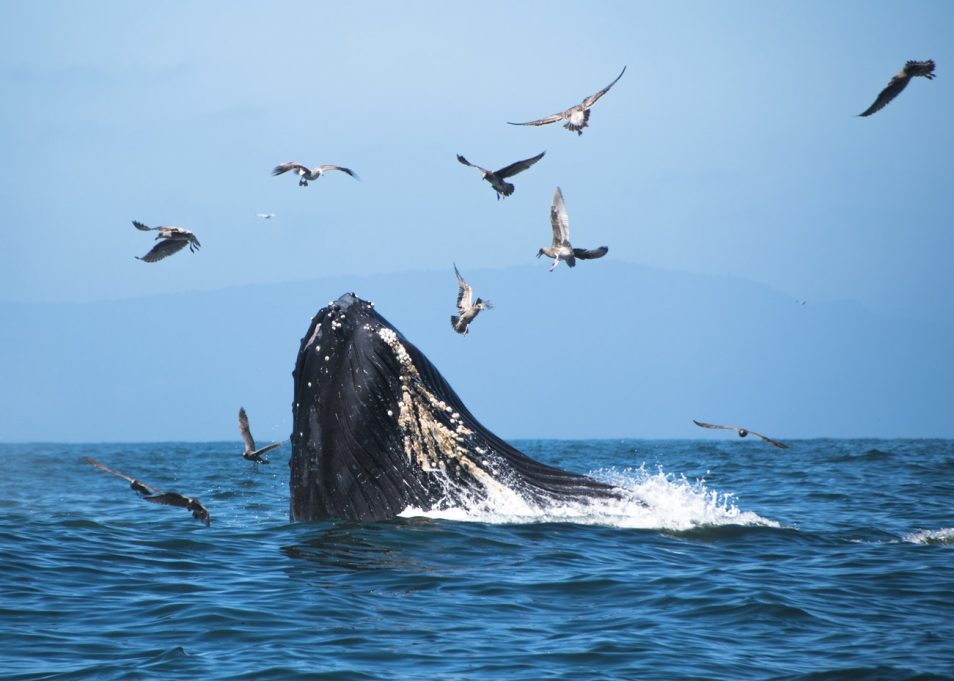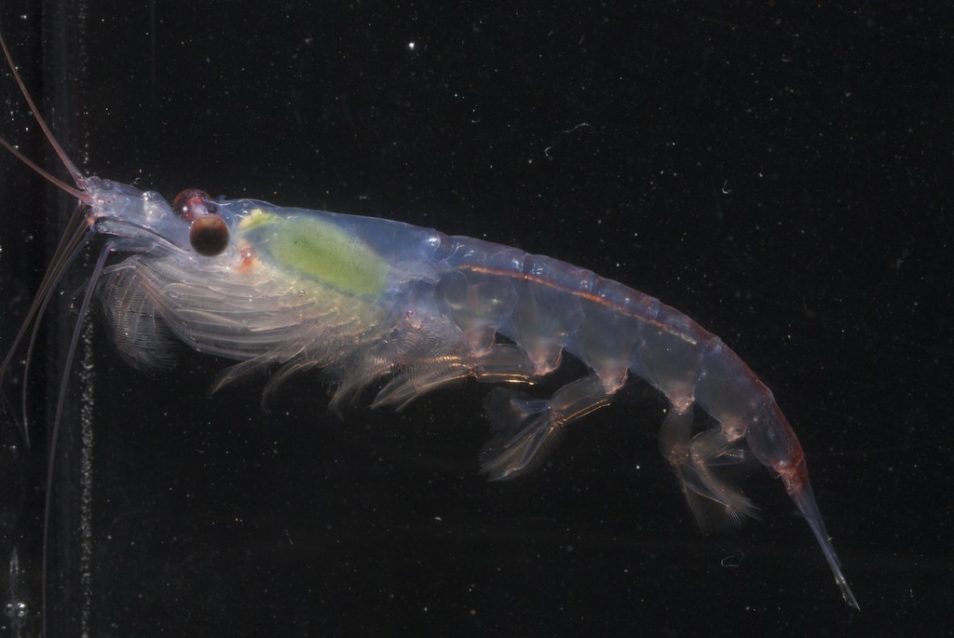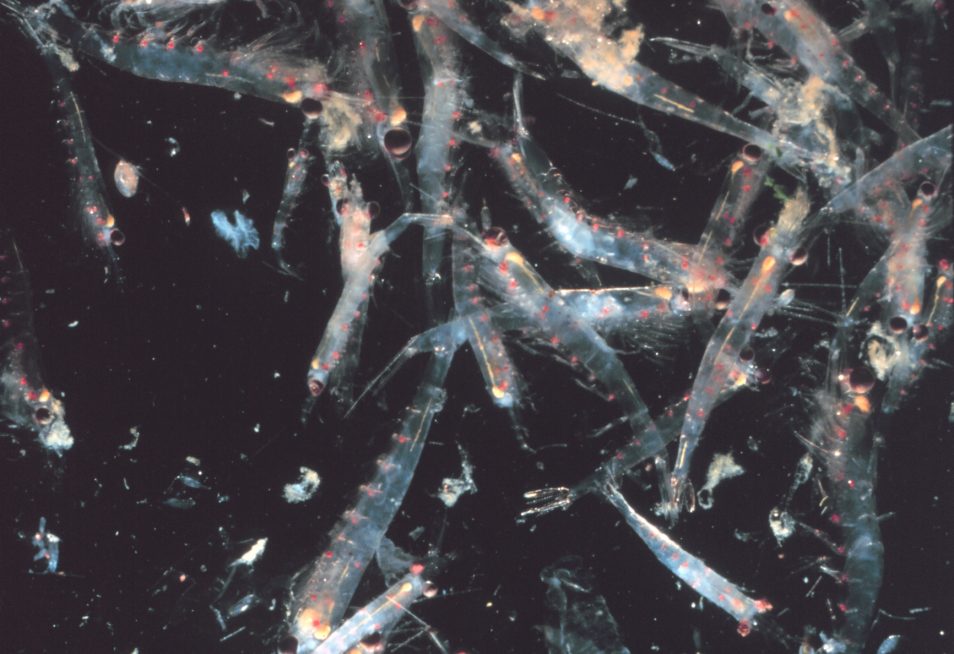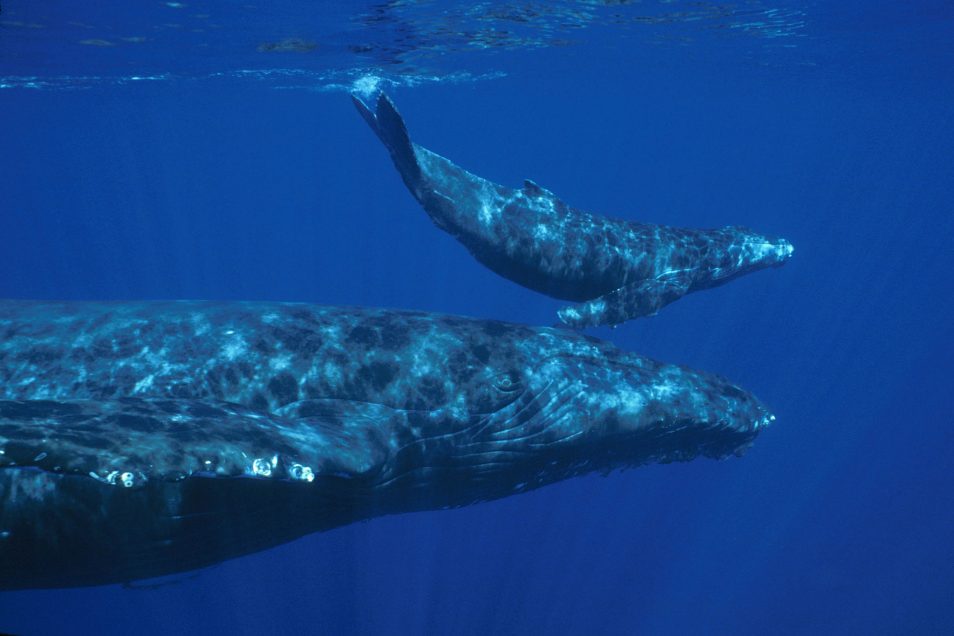
Whales love krill. One adult whale can eat up to 3 tonnes of krill in one day. But how will climate change affect krill numbers? Image: Humberto Braojos
Krill, krill, delicious krill
Baleen whales eat a lot of krill. And because krill are found in swarms, this allows whales to consume large quantities to sustain them. One adult blue whale can eat up to 4 million krill — that’s more than 3 tonnes! — in just one day. That’s a lot of krill!
Over the last century, historical whaling pushed many whale species close to extinction. Estimates indicate that whale numbers in the Southern Hemisphere are slowly recovering, but many populations are still far below their pre-whaling numbers.
We want to understand the pressures on whale recovery in the future. So our researchers have been investigating the influence of climate change on krill levels in southern oceans. We want to know how climate change could affect whale populations — including Blue, Minke, Humpback and Fin whales — across the Southern Hemisphere.
Dr Viv Tulloch led the new study for CSIRO and University of Queensland. She says this is the first time climate change has been linked to future whale populations in the Southern Hemisphere.

Krill are shrimp-like crustaceans. One krill may be roughly 5 cm long, but together they form a giant link in the global food chain. Image: Beth Simmons
Krill for their fill
Krill is the main prey for baleen whales. So we looked at how changes in the marine environment, such as changes in ocean temperatures, primary productivity and sea-ice, could affect krill biomass and whale populations in the Southern Hemisphere.
“A rise in water temperature will likely impact krill numbers, as they are well adapted to cooler Antarctic waters,” explains Dr Tulloch. “This could have a knock-on effect on whale populations. Whales form the higher trophic levels of the marine food web and rely on lower level trophic species, like krill, to survive. In other words, whales may have to compete for food because of changes to the ocean environment and the amount of krill available for whales to eat.”
“The impacts on whale species could differ, depending on the region, where they feed and their current levels of recovery from historical whaling. For example, whale populations in the southern Pacific Ocean were heavily harvested last century, so those whales could have less krill to feed on in the future compared to those in the Atlantic and Indian Oceans.”
The results are based on high emissions climate trajectories using a CSIRO oceans-climate model linked to a Model of Intermediate Complexity for Ecosystem Assessments, known as MICE. The advanced modelling tool used a range of to generate whale population predictions to the end of the century.
“Using MICE enabled us to connect the life history of whale species in the Southern Hemisphere with food availability and how climate drivers could determine population numbers in the future,” says Dr Tulloch.

A swarm of krill. With climate change, scientists estimate that there may be less krill in the Pacific Ocean in the future. Image: Jamie Hall from US NOAA.
Temperature changes, behaviour changes
Baleen whales in the Southern Hemisphere rely on stable environmental conditions. They use the energy from prey found in polar waters to travel long distances to their nursery grounds in warmer waters, to then travel to feeding grounds in the Antarctic, where prey is easily found. Dr Tulloch says that their slow population growth rates and dependency on krill make baleen whales sensitive to changes in the marine environment. But her research also explored other scenarios that could see whale recovery continue.
So how do we estimate krill abundance and whale recovery, in our Southern Hemisphere? First we need to understand future carbon emissions and how this impacts the ocean, by rising ocean temperatures, for instance.
“It might also mean that whale populations will need to adapt to changing environmental conditions and prey distributions,” says Dr Tulloch. “As ocean temperatures increase and sea ice decreases, whales may have to travel greater distances for prey. This means that their migration behavior may change. We could see recovery outcomes improve for some species, such as blue whales, as they are not as dependent on krill in the warmer regions where krill declines are predicted.”
Paving the way for whale recovery
Aside from climate change, whales face other pressures too, such as becoming bycatch, getting entangled in nets (especially for Southern Right and Humpback whales) and shipstrike. However, the recovery of baleen whales in the past few decades has been shown to be on a positive trend and Dr Tulloch hopes the conservation efforts for recovery continues.
“Southern Rights were heavily harvested and were reported to reach just 300 globally before anti-whaling laws were established,” explains Dr Tulloch. “On average, they raise one calf every three to five years, which means they are slower to recover from population impacts than some of the other species like humpback whales which raise a calf on average every two years.”
This new research fills an important knowledge gap concerning baleen whales and how they might respond to a changing climate in the future. Managing krill abundance and future emissions could help ensure populations continue to recover.

The research into krill and climate change fills an important gap in our knowledge of ongoing whale recovery. Image: NOAA Photo Library


15th June 2020 at 12:31 pm
How will the rising sea temperatures affect the migration of Humpback whales?
23rd June 2020 at 12:29 pm
Hi Paddy, impacts on whale species could differ, depending on the region, where they feed and their current levels of recovery from historical whaling. For humpback whales in particular, they feed at lower latitudes than baleen whales. If krill in these regions shift further south to track cooler waters (as many marine organisms have been shown to do), then it may mean that humpback whales need to travel further to access their preferred prey. An alternative is that they would shift to eating more copepods (currently a component of their prey at lower latitudes), but there may be energetic disadvantages as they currently feed mostly on highly nutritious and large krill rather than copepods. The exact effect is unknown but is of some concern in the long term if ongoing rising emissions keep increasing sea temperatures.
Thanks,
Georgia
Team CSIRO
18th September 2019 at 5:45 pm
Hi,
Do your have published article in any journal related to this work?
Please send me
18th September 2019 at 6:25 pm
Hi Rabia,
Yes, you can find the article about krill, whales and climate change here: https://onlinelibrary.wiley.com/doi/full/10.1111/gcb.14573
Thanks!
CSIRO social media team.
8th March 2019 at 9:17 pm
Krill are actually adapted to cold Antarctic waters, so in the mid-latitudes where temperatures are expected to warm in the future beyond the threshold for krill survival (4 degrees C), krill numbers will likely decline. Colder waters are more suitable for their survival than warmer waters.
7th March 2019 at 12:42 pm
I suspect this article has more to do with pushing the theory of “climate change” than providing any solid scientific evidence on whales and krill.
The use of phrases such as – how climate change ‘could’ affect whale populations, ‘could’ affect krill biomass, ‘will likely’ impact krill numbers, This ‘could’ have a knock-on effect, whales ‘may’ have to compete, ‘could’ have less krill to feed on, how climate drivers ‘could’, how they ‘might’ respond, With climate change, scientists ‘estimate’, and so the story goes just like every other study into the future of the earth’s climate. Speculation, not scientific evidence.
The other concern is the dependence on computer modelling – “The results are based on ‘high emissions’ climate trajectories using a CSIRO oceans-climate model linked to a Model of Intermediate Complexity for Ecosystem Assessments, known as MICE.”
Perhaps articles and studies based on speculative research and unreliable modelling should not be aired until there is substantial solid evidence of actual outcomes, although that goes against the biased agenda of “stakeholders” in “catastrophic climate change”.